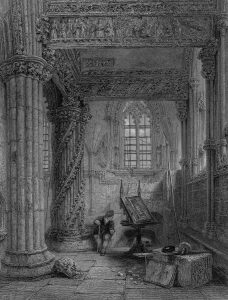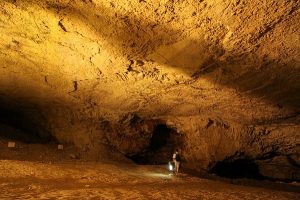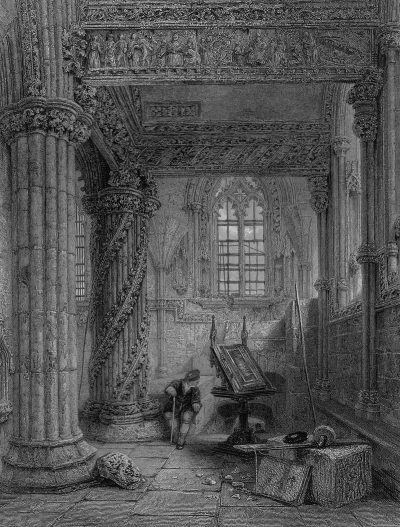Article Written by
Duncan Burden
Freemasonry actively uses the art of construction as a metaphor to instruct its members in how to be a better person. Given the popularity and respect that the vast majority of Masons have for their Craft, it is not surprising that many skilled individuals have reversed that metaphor and used buildings to represent Freemasonry.
This process of using buildings to convey ideas and principles is ancient, and can be found in the layout of Egyptian Temples, Gothic Cathedrals, even the Elizabethan theaters. Here are few buildings and locations that have often been linked to Freemasonry – but many remain a mystery if they really do or not. What do you think?
Top Ten Mysterious Locations with Masonic Symbols and Secrets of Freemasonry:
1)The Globe Theater
This building was originally constructed in 1599, but in 1997 an authentic replica was opened to be used. In 1992, Joy Hancox was researching a collection of Geometric drawings known as the ‘The Byrom Collection’. Part of which showed the possible layout of the theater as not simply a practical construction but as a geometric representation of the world – personifying Shakespeare’s famous line ‘All the world’s a stage’; a line probably sourced from Petronius’s (an ancient Roman satirical author) line ‘…all the world is a playground’.
As geometry is a focal part of Freemasonry, Hancox took the collection to the United Grand Lodge of England, where the respected Rev’d Neville Barker Cryer, (Past Grand Chaplain UGLE, Prestonian Lecturer, Batham Lecturer and international Masonic lecturer) believed them to be important documents relating to the early development of Freemasonry. This draws an early reference between Freemasonry, Geometry and the how it can be used in building designs.
2) Royston Cave
Located in the small English town of Royston, under the Melbourn Street, is this man-made cave. Its location marks the crossroads of two ancient roads in Britain; namely Ermine street and Icknield Way. It was discovered by accident in 1742 when workmen dug and discovered a buried millstone and removed it to find a shaft leading down into the chalk walled cave.
The Cave is a circular, with a domed roof. It is 8 metres (26 feet) high and 5 metres (17 feet) in diameter with a shallow octagonal step around the bottom. In this step is a missing section with resembles a small ditch, and is strangely named ‘the grave’. On the walls are an array of cravings, many of which are obscure, but some a clearly depicting swords, saints and crucifixions. The cave has been linked to the Knights Templar, the hiding of Priests, and a theory that states early Masonic Freemasonry was performed there. Its origin and purpose is still a mystery.
3) Roslyn Chapel

So many Freemasons see this chapel as a place of historical pilgrimage. Even more so after the release of Dan Brown’s ‘The Da Vinci Code’. The building was originally known as the Collegiate Chapel of St Matthew, and was built in the 15th century in the village of Rosin, Midlothian in Scotland. The Chapel crests a small hill in Roslin Glen near to a Sinclair castle (a small stately home).
The Sinclair family held the heredity role of being the Grandmaster of Scottish Freemasonry, as such, a lot of speculation of Masonic symbolism has been attributed to the Chapel. Certain engravings do appear to represent various Masonic legends and methods of recognition. Yet, the most compelling theory relates to the three ornate pillars that are situated near the altar end of the church. The first notable aspect is that there are three columns.
The significance of this is because normally pillars are found in divisions of two. Three pillars are specific to Freemasonry. Equally, pillars in buildings, especially religious buildings, normally match in design, but each of the pillars in the trio are different – appearing to imply they each have a different symbolic significance – another Masonic concept.
4)Rennes-le-Château
This infamous village is found in the South of France and the mystery relating to it not only inspired the same ‘Da Vinci Code’ story but has also produced nearly half a century of treasure hunting. The treasure (virtual or intellectually) was meant to have been found by a priest named Bérenger Saunière. It is claimed that he, in the late 19th century, became wealthy overnight. Although his secret income was sporadic, he managed to have spent a fortune in renovating the village church, to have commissioned a local manor house, and financed the building of a curious tower.
Although speculation surrounds the truth of many of the issues, what is impossible to ignore is that these structures exist and all were apparently financed by the priest. For myself, certain elements seem to point to a Masonic connection. Firstly the priest appeared to have instructed, amongst other things, for a specific motto to be inscribed above the church door, which reads as ‘Terribilis est locus iste’.
This phrase could be considered traditional above church doorways (but outdated in the 19th and 20th century), as it comes from a certain passage in the Bible. It relates to when Jacob ascends a ladder into heaven and is stunned by what he sees. This ladder is a focal illustration in Freemasonry and a central symbol in the First Degree tracing board lectures.
In addition, the church has a blue ceiling and part of the floor is chequered, just like a Masonic Temple. A similar Masonic link can be found in reviewing the strange tower the priest commissioned. This tower was given the name ‘Tour Magdala’, curiously this term was a specific Masonic password released in a public exposure of French Freemasonry for the second degree.
A similar significance can be found in the naming of the manor house financed by the priest, which was called ‘Villa Bethania’. Curiously this also relates to a Biblical story; namely the raising of Lazarus. This act of raising from the dead has repeatedly been linked to the raising of a Master Mason from the grave in third degree ceremony. As such, each of the three buildings created to the priest all appear to relate to each of the Craft degrees of Freemasonry – and there is so much more.
5) Shell Grotto
This is a mysterious and ornate subterranean passageway discovered in 1835, in the county of Kent in England. Its actual age and original purpose is unknown, but almost all of the walls and roof of the structure are covered in genuine sea shells, approximately four and half million of them. It is likely that the shells were sourced locally, but the reasoning is unclear. As for the decoration itself, most are random patterns set in regular squares. As for the structure itself, it is mainly a winding passage leading to a circular domed room and then through to a doubled cubed room. Freemasonry does use a circle as a symbolic reference, and in older rituals a significant moment in ceremonies involved standing in a circle, which might offer an explanation of that location. Although a more significant Masonic link is in relation to the double cubed room. This is because a Masonic temples are meant to be a double cube or double square. Unfortunately no specific masonic symbols exist, yet the study of shells, from a geometric perspective, was once taken as evidence of a mathematical design of a Divine creation – a very Masonic concept and something Masons were once instructed to study.
6) The Paris Catacombs
These are technically underground ossuries, containing the remains of around six million people. Originally the network of tunnels were ancient stone mines, but in the late 18th century, when cemeteries in Paris could no longer facilitate new bodies, a decision was made to rebury the centuries of existing corpses in the mines.
Instead of laying each body individually, and due to many bodies simply being bones, the remains were just gathered in mass and stacked in groups underground. Some people obviously had an artistic flare and the bones facing the pathways were arranged in patterns and in designs. Some of these designs echo those found in Freemasonry.
As many know, death, and consequence of divine judgment, is an important element of Craft Freemasonry, so it is not impossible that coincidence is the cause of the similarity of those images, but even so, the catacombs have become an underground garden of death, with many spots where a person can sit to contemplate mortality; another Masonic principle. As such, many Freemasons find an affinity with the location, and walk through the entrance – named ‘The Gate of Hell’.
7) The Triangular Lodge
This specific building is called a ‘folly’, meaning a structure, normally a decorative building, for a garden. These structures, during the 16th and 17th century, often were constructed not only to decorate a garden, but to also convey a message. This particular building was built in the late 17th century by Sir Thomas Tresham in Northamptonshire, England.
Tresham was a Roman Catholic and was imprisoned for 15 years for refusing to become a Protestant. On his release, he designed this building to represent his faith and defiance. The entire structure represents the Holy Trinity. It has three walls, each 33 feet long and each with three triangular windows. Beneath the Tresham’s coat of arms on the building is the Latin inscription ‘Tres testimonium dant’, which itself means ‘The number three bears witness’ as well as meaning ‘Tresham bears witness’.
The principal room has a spiral staircase in one of the triangular corners, which leads up to two over rooms. Although being an openly Catholic representation, the building has frequently been linked to Freemasonry. Besides the repetition of the value of three, which is also present in Freemason, there is also a significance to a spiral staircase linking three stages. In addition, the location of the monogram of IHS and chalice found pinnacling the structure on the triangular chimney has been taken as relating to the final step of English Craft Freemasonry (the Holy Royal Arch) and possibly the quest for a Grail – a holy lost relic.
8) The Circus and Square
These are two locations found in the Ancient English city of Bath. The Circus is a circular set of houses with three road entrances, each equally spaced out – meaning that each segment of housing faces one of the entrances. It was designed by the John Wood, the Elder. Wood was an extremely accomplished architect and was passionate about ancient British history and Freemasonry.
His passion for Freemasonry has created many theories of how early Speculative Masonry influenced his designs. This is very relevant to his designs of the Circus that includes the representation of a circle and the number 3. In addition, the houses have a banner along their fronts of carved images, many of which seem to directly relate to Freemasonry.
Curiously, prior to building the Circus, Wood also designed nearby Queens square. This perfect square of classically presented Georgian houses, is linked to the Circus by a single straight road. It was noted by the historian Stephen Ben Cox that when this is viewed from the air, the combination forms the image of a key – a Key was a very prominent symbol in early 18th century Freemasonry.
9) Washington DC
Even before Dan Brown popularized the theory more in his book ‘The Lost Symbol’, many writers had already claimed that the layout of Washington DC was to a Masonic design. The list of theories is extensive, but the majority of propositions relate to how many roads converge at specific angles. As these angles are mirrored with others, shapes like pentagons and pentagrams appear to be clearly formed.
Some believe these create large versions of the familiar Masonic image of the Square and Compasses, whilst others say that demonic pentagrams are the aim. As the apexes of various angles point to significant buildings, such as the White House and the Capitol building, it does seem to imply intent.
The masonic connection is highlighted further when it is considered that the architect of the original plans for the city was Pierre Charles L’Enfant, appointed by the two Freemasons, George Washington and Thomas Jefferson. Even so, the convergence of lines to significant locations could also be acknowledged as being simply practical and stylish, and the opportunity to design a city on those principles would seem logical, especially for a ‘new’ capital of a country looking to establish itself.
10) Zedekiah’s Cave

This location is also known as Solomon’s Quarries. It is a 5 acre site underground that runs under the Old City of Jerusalem. Legend has it that this was where the stones were gathered and cut for King Solomon’s Temple. From an academic perspective, Archaeologists appear to confirm that the quarry is at least several thousand years old and is the reminisce of the largest quarry in Jerusalem – stretching from the Jeremiah’s Grotto to the famous Garden Tomb.
It’s relation to the Temple of Solomon makes it one, if not THE, most significant location to a Freemason, as King Solomon’s Temple is the most important building in Masonic literature. The importance of this building within Freemasonry cannot be underestimated, as not only is the complete structure and its construction the basis of the literal part of Masonic legends, the parts of the building itself hold their own metaphoric value and purpose.
There are even Masonic rituals that relate specifically to the quarries. As such, this location holds a very tender significance to Freemasonry and Masons have been drawn to the location for over a hundred years. The first recorded Masonic meeting there was held in 1868. Then, with the forming of the first Masonic Lodge of Jerusalem (Royal Solomon Mother Lodge No. 293) rituals began to be held more regularly. Out of all the locations on the list, this would surely be the most personally engaging location for a Freemason.
~Article written by Duncan Burden
Duncan Burden enjoys researching history. Although he often writes on Masonic issues, since he has been a Freemason for most of his adult life and is a member of various Masonic bodies, such as the Royal and Select Master Masons, and Operative Masons, he takes pleasure in writing on all historic, mysterious, and exciting topics.
He was born on the Norfolk Coast, and now lives in Hertfordshire, England.


Mysterious and fascinating. Symbolism is really a powerful reminder of depth in meaning.
Thanks